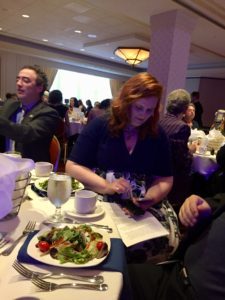Cat Rambo's Blog, page 34
August 14, 2017
Cat’s Schedule at GenCon 2017
Thursday
10 AM Story Craft: Where Do You Begin Your Story?
12 PM Writing 101: Careers – What a Writing Career Looks Like
Friday
Lunch plans
5 PM Business of Writing: Handling Problem People — From Divas to Needy Fans to Harassers
7 PM Writer’s Craft: Using Tension to Drive the Narrative
8 PM Gaming with SFWAns!
Saturday
1 PM Business of Writing: Using Social Media
5 PM Writer’s Craft: How to Revise Right
I’m in walking distance of the convention this time, huzzah!
August 10, 2017
SFWA and Independent Writers, Part One: History of the Organization
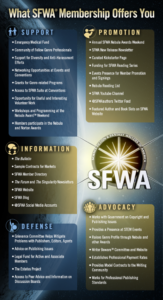 As part of a Twitter conversation, one of my favorite gamewriters, Ken St. Andre, suggested I write up something about SFWA and independent writers that goes into enough detail that people can understand why — or why not — they might want to join. This is part one of a multi-part series that will talk about some of the history behind the decision, and in this first part I want to talk about the organization prior to admitting independent writers. Part two will discuss how SFWA came to change membership criteria in order to make it possible for people to qualify for membership with indie sales in 2016, and some of the changes made as part of planning for that expansion. Part three will focus on how SFWA has changed in the intervening time, while part four will look at what I see as the changes that will continue as we move forward over the next decade. In all of this, I’m trying to provide something of an insider’s look that may or may not be useful, but certainly will be full of many words.
As part of a Twitter conversation, one of my favorite gamewriters, Ken St. Andre, suggested I write up something about SFWA and independent writers that goes into enough detail that people can understand why — or why not — they might want to join. This is part one of a multi-part series that will talk about some of the history behind the decision, and in this first part I want to talk about the organization prior to admitting independent writers. Part two will discuss how SFWA came to change membership criteria in order to make it possible for people to qualify for membership with indie sales in 2016, and some of the changes made as part of planning for that expansion. Part three will focus on how SFWA has changed in the intervening time, while part four will look at what I see as the changes that will continue as we move forward over the next decade. In all of this, I’m trying to provide something of an insider’s look that may or may not be useful, but certainly will be full of many words.
So what is/was SFWA, before the change? I’m going to paint in broad strokes here based on my understanding and research. (I’d love to see a book devoted to the history of SFWA at some point and one of our current projects is trying to collect that, under Vice President Erin M. Hartshorn’s direction.) The organization started in 1965 with Damon Knight organizing a number of professional genre writers in order to force publishers to treat writers better, namely pay them decent rates in a timely fashion while not taking excessive rights.
One of the first writers they helped was J.R.R. Tolkein, whose work has been pirated in the United States, Bob Silverberg said to me in email that there’s very few of those founding members left, but they included himself, Brian Aldiss, Harrison, Robert Heinlein, Kate Wilhelm and a host of distinguished others. Silverberg says Ellison as well, though the document he sent me seems to contradict that. At that time it was the Science Fiction Writers of America.
Initially SFWA was exactly what you would expect of a volunteer organization run by the most chaotic, capricious, and disorganized creatures possible: science fiction writers. Stories abound, including records getting lost because someone’s cat peed on them, Jerry Pournelle inviting Newt Gingrich to be the Nebulas toastmaster and a subsequent heated brouhaha that included some people walking out of the ceremony and Philip K. Dick agitating to get Stanislaw Lem expelled. My favorite remains Joe Haldeman’s account of the SFWA finances being somewhere in the realm of $2.67 when he became SFWA treasurer, so he bought the notebook to keep track of them out of his own pocket.
The membership requirements were proof of a professional sale. Over time the memberships would expand, allowing associate members to join with a story sale, bringing in publishing professionals as associate members, and introducing estate and family memberships. The question of requalification – making members prove at intervals that they were still producing — was raised more than once, usually with plenty of heated discussion — but never implemented.
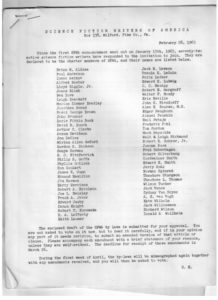
The charter members of SFWA.
Along the way, SFWA grew and became an organization that did what its founders had envisioned, and more. Under Jerry Pournelle’s leadership, the Emergency Medical Fund, which helps writers with medical emergencies affecting their ability to to write, was implemented. A similar fund for legal situations followed. Ann Crispin and Victoria Strauss launched Writer Beware under SFWA’s auspices and began the fight to keep new writers aware of unscrupulous editors, publishers, and agents.The fight to keep writers from being preyed upon remained a focus for SFWA. In 2004, a group of SFWAns, under the direction of James D. McDonald, wrote Atlanta Nights in order to expose the unscrupulous practices of PublishAmerica. The book, deliberately constructed to be unpublishable, featured two identical chapters, a chapter of computer-generated gibberish, missing chapters, and a list of characters whose names spelled out the phrase “PublishAmerica is a vanity press”. It was accepted for publication by the company, which withdrew the acceptance after the hoax was revealed.
Another focus would be an effort unsurprising for a group of writers: establishing a set of awards, the Nebulas. While that may seem a bit cynical on my part, I’ll point much less cynically to the effect of the awards: the recognition of some of the best and most interesting F&SF over the years via a prestigious award group that has grown to include screenplays and Middle Grade/Young Adult Fiction as well as recognizing achievements in the field via the Kate Wilhelm Solstice award and the SFWA Grand Mastership.
Other good stuff that SFWA took on or did over the decades included a publisher audit that helped draw attention to auditing practices, started the SFWA Bulletin, a public-facing magazine aimed at educating and informing professional F&SF writers, and many efforts that started, worked for a while, and then died a graceful (sometimes less so) death when the volunteer driving them lost interest, died, or got fed up with SFWA.
Those membership requirements continued to change over the years, usually to reflect inflation. (To a degree. I’ve calculated that if we matched the buying power of the original rate, we’d be looking at closer to 20, 25 cents per word than the current 6.) The Science Fiction part was expanded to include Fantasy.
Over the decades, SFWA communications took multiple forms. The paper Forum was intended only for members and featured a letter column that was often lively in pre-Internet days. As the Internet grew in popularity, that shifted. The message boards were originally hosted on Compuserve and later moved to SFF.net, where they gained a name for being acerbic, nasty, and often contentious to the point where, when I joined, I was warned not to visit them. When I did, I found them considerably less heated than had been described, and not actually full of epic levels of bon mots, clever insults, and sundry literary feuds. The SFWA Handbook appeared in multiple forms, compiling articles of interest to working F&SF writers. The SFWA Bulletin became SFWA’s outward facing publication, publishing not just what SFWA was doing, but articles of interest to all genre writers.
During Russell Davis’s term as SFWA President, Davis did something that would radically affect the direction of the organization: began the move towards reincorporation as a 501c nonprofit in California. The organization had originally been incorporated in Massachusetts, which meant there were restrictions that included having to use paper ballots for elections rather than being able to use electronic means. I will confess here that when the advantages of it all have been explained to me in the past, my eyes glaze over a bit, so I may not be the best person to speak to all of the motivations.
I joined SFWA in early 2006 but did not do much with the organization, as an associate member with a short story sale to Chizine. I found the message board system unwelcoming and generally once I’d joined, I figured I’d checked that box off my writerly bingo card and could now move onto something else.
However, I got asked to volunteer for a group assembled after an incident where a bunch of files got pulled from Scribd, including a number whose rights-holders did not want them pulled. That was an interesting group and I learned a lot about copyright as a result. I also served on a jury for the Nebula award for short story; our job was to put one thing on the ballot that we thought would otherwise get overlooked. My impression of SFWA was, I think, like most members: I didn’t think much about what the board was doing and I took advantage of some of the SFWA offerings, like the SFWA suite at conventions, the local reading series, and reading the Bulletin.
In 2012, I was asked if I’d take over as head moderator of the SFWA discussion boards, which had moved away from SFF.net onto the SFWA website. I had been the moderator of an often contentious discussion board for a game community as well as a BBS, and so I felt reasonably comfortable taking on the role. What I didn’t foresee was how that role would change my relationship to the organization, making me much more aware of its internal workings. And then, Steven Gould spoke with me in 2014 and asked if I’d consider running for Vice President. It was an interesting time in SFWA’s history, I liked the people, and so I said yes.
In Part Two, I’ll talk about the discussion and process by which SFWA came to admit independent writers. #sfwapro
August 1, 2017
Summing Up July 2017
 Over halfway through the year, and here’s some of the happenings for July.
Over halfway through the year, and here’s some of the happenings for July.
Online I taught workshops on Story Fundamentals, Flash Fiction, Writing Steampunk & Weird Western, Moving from Idea to Draft, and Editing 101. I’ll announce September and October classes next week. I also got a chance to teach at the Pacific Northwest Writers Association conference mid-month, which was terrific.
I wrote short stories “Say Yes,” “A House Alone,” and “Another Selkie Story,” all of which were posted for Patreon supporters. (You can see a pictorial version of my July Patreon here.) As always, I’ve got a crop that I’m working on: highlights include a story about a woman who buys a magical talking mask only to find she doesn’t agree with what it’s saying. I also worked on urban fantasy Brazen, about a magic-wielding post apocalyptic hellion.
Videogames I’ve been playing are Stardew Valley and Dream Daddy. Curse whoever introduced me to them. In RPG news, my Star Wars RPG game managed a session. You’ll be glad to know my prophet/conwoman continues to talk her way out of things successfully but the rest of the party didn’t want to take her suggestion of throwing a mysterious crate out a fifth-floor window in order to discover the contents.
I continue using Habitica, which I blogged about here. I have a follow-up post in the works.
SFWA work included working with the Galaktika settlement, answering a bunch of e-mails, a multiplicity of video calls, and nudging a couple of projects along.
Books I read included the following. I’ve bolded the ones I particularly enjoyed:
Karen Abott, Liar, Temptress, Soldier, Spy: Four Women Undercover in the Civil War
R.S. Belcher, The Brotherhood of the Wheel
Mike Caro, Caro’s Book of Poker Tells
Ramsey Campbell, Demons by Daylight
Tori Curtis, Eelgrass
Laurell K. Hamilton, Crimson Blood
Elizabeth Hand, Winterlong
Georgette Heyer, The Grand Sophy
Alice Hoffman, The Probable Future
Michael M. Jones (editor), Scheherezade’s Facade
Damon Knight, The Futurians
Tanith Lee, Red as Blood
Gabriel Squalia, Viscera
Glynn Stewart, Starship’s Mage
R J Theodore, Flotsam
Kentaro Toyama – Geek Heresy
July 10, 2017
Playing at Being Motivated: Habitica for Writers
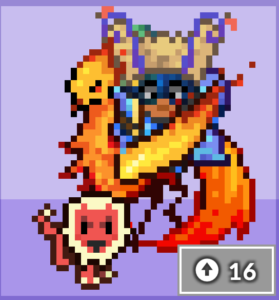 One thing that was fascinating about this year’s Nebulas was the chance to meet so many people in the publishing industry, including a couple of the founders of Habitica.
One thing that was fascinating about this year’s Nebulas was the chance to meet so many people in the publishing industry, including a couple of the founders of Habitica.
Habitica is a motivational game. It lets you gamify your daily tasks and to-do list, turning them into challenges you face in the game. As you complete tasks, you gain levels and items in the game, giving you an extra push to get things done. You can also set it up so you lose points for doing things, if there’s habits you want to avoid. There’s a social aspect; you can join parties and guilds in order to share your progress with friends.
I am always on a quest for a method that will help me stay organized. Various systems have come and gone, some more successful than others, and I’ve learned a few things about how to make such systems more effective. As I share how I am using Habitica, I’ll include some insight into how that knowledge shapes that use. I’ve been logging into it consistently for two weeks now, and I believe it’s going to stick, because I’m finding it very effective for a) nudging me to do things, b) helping me remember stuff, and c) motivating me to use free time and options (like snacks) better.
Core Component: Dailies, Habits, and To-dos
The key to Habitica is its tasks, which fall into three categories: dailies, habits, and todos.
Dailies are a key component. For people familiar with MMORPGs, this concept will be very familiar. They are things you can do once a day that earn you experience. These are effective because — for me at lest — I get more done doing small chunks consistently than with sporadic sustained bursts. For example, someone learning to play a musical instrument is going to do better with shorter, more frequent practice sessions than one long sustained session. You can get complicated with dailies, but the only things I actually use much is difficulty settings (trivial/easy/medium/hard). The harder the task, the more experience /gold it yields. And they are mandatory – if you miss a daily, you lose hit points.
Here’s my dailies:
Checking the calendar and planning my day. This means looking at the calendar on my PC as well as Google calendars for the various roles I’m currently juggling. One reason I’ve implemented this is that in the last half year I’ve missed a bunch of stuff because I wasn’t in the habit of doing this. With it as a morning task, it’s something I can do quickly and get checked off. This is probably one of the smartest habits anyone can get into, and so I’m making sure I check it off in the morning.
Writing. My goal of 2000 words is set to HARD difficulty level because it’s a top priority plus, well, it’s hard. At the same time I’ve got an accompanying habit set up as trivial: 250 words. Each time I get a chunk of words done, therefore, I can achieve a pellet’s worth of gratification without feeling like I’m padding my count too much, and build towards (hopefully) being able to check off that 2k word goal. This also means even if I don’t hit my goal, I do get some reward for getting partway toward it. This was originally 500 word chunks, which wasn’t as effective was I’d hoped, so I’ve changed it to 250 words. This is much more doable, and is an example of how you can “chunk” your work in order to make it more manageable. I’m more likely to sit down and knock off a few hundred words than 2,000 in one sitting. Doing it this way means I have some reward for my effort even on days when I don’t hit the 2k target, while I have additional reason to hit that goal (and even some to go past it.)
Basic self care stuff. People suffering from depression know that it’s easy to mope around and forget to do some of the stuff that will help you feel better, like food, showers, and getting out into the sunlight. I’ve got one task here, easy level, with the basics that I must hit as a checklist. I’ve pulled out “Take my medicine” as a solo easy level task because this is something I am perpetually bad about and I really want to get on the stick about it. This has been surprisingly successful.
30 minutes of housework. Like the words, I’ve split this into smaller chunks, because I am much more likely to go work in the kitchen for 5-10 minutes if I can get some points for it, and thus I pick away at the overall task. As I continue fine-tuning this, I may add a checklist that will remind me to do quick decluttering sweeps and anything else that really should get done every day, but since the house is usually pretty clean, it’s just a matter of staying on top of it. Can I run the household effectively on 3.5 hours a week? Undoubtedly not and I’ll end up putting in two or three times that, but this means that I keep on top of things on a daily basis.
Exercise. Each of the components of my routine is a separate task, medium level, which I think I will drop to easy at some point. Mainly I want to make sure I get my daily walk in, do some stretches (Steven Barnes turned me onto this great book), and a little strength training, because I am a big wimp, and would like to be less of one.
Self-improvement, mainly 10 minutes of language drill each in Spanish and Mandarin. I know from experience that doing it daily will work while cramming isn’t particularly effective (or likely). At the same time extra practice set up as habits in order to encourage me to do more than the basic daily allotment if there’s time. I use Duolingo for Spanish drill, combined with reading fiction in Spanish; for Mandarin, I’ve got Rocket Chinese and an iPad game. And an additional 10 minutes of practicing at something to build my dexterity.
Something outside my comfort zone. This doesn’t have to be big, although the recent shark cage dive was definitely a good example. But it can mean initiating an interaction I’ve been avoiding. It does have to be outside my normal comfort zone, though. For example, while smiling at or saying hi to a stranger might be a good one for my shyer friends, it’s something I do anyway. Pick things that you need to be reminded to do.
Habits are things you should do more but a, don’t necessarily need to do every day and b, might do more than once. For example, here’s some of mine:
Eat a fruit/vegetable. This makes me more likely to grab a healthy snack rather than chips or candy.
Promotional tasks. I’ve got reminders to promote my Patreon, the Rambo Academy, and my live classes. This nudges me to be better about tweeting, posting on FB, and other social media venues.
50 pages of nonfiction reading. This nudges me to get through a particular section of my to-be-read pile and not just read novels.
The aforementioned 250 words written (this must be fiction), which kicks me to be productive even after I’ve knocked off my requisite 2,000.
I’ve included some other tasks to encourage me to do them on a regular basis, such as posting for Patreon supporters, clearing emails, sending out submissions, editing 50 pages, etc.
Watching television is a negative habit (because I want to trim down on how much I watch), so each half hour costs me experience and points.
Todos are one-time tasks. This functions for me as a combo of todo list plus kick in the butt to get those items knocked off the list. Right now the list has a couple of appointments I need to make (due by the end of this week), two manuscripts I should read, a blurb to write, and several SFWA projects that I need to nudge along. One of the habits I’m working at is, when looking at an e-mail, either answering it immediately or turning it into a todo here that has an expiration date. This does nothing to address the pile of past todos, but one useful to-do, due Sunday evening, is looking over the week to come and setting up todos for things that I want to get accomplished that that week that aren’t already covered by a daily, habit, or existing to-do.

Why Habitica Works For Me
First and foremost, it’s a game, and I am a game addict. Gamify just about anything and I’m there. Habitica has random little rewards as well as reward for steady effort, set up in an addictive and gratifying way. It’s fun. Because I’m at the keyboard so much, Habitica is easy to access, but even when I’m not, there’s a mobile app that I’ve installed on my phone.
The game rewards me with coins that I can spend in the game or that I can spend outside the game on rewards I’ve decided for myself, such as buying a new book, which costs me ten gold on Habitica.
It also gets me to create reminders to myself in the form of todos, as well as provides options for odd moments. Since I work at home, I often get up and roam around the apartment, thinking about a story. Habitica encourages me to spend that time in the kitchen doing 5 minutes worth of tidying up, or taking a break for language drill.
There’s a strong social aspect to Habitica, including being able to group up with people and undertake quests in order to find additional items and pets. This encourages accountability; one of the things I’ve found about these systems is that if you know other people can see your progress (or lack thereof), you are more likely to follow through.
One thing I’ve been cautious about is overloading the game and tracking everything obsessively. So each week, as part of that planning session, I look to see if there’s anything I’m not doing. If so, do I need to make the reward greater? Or should I just remove it from my slate if it’s something optional? After that, I can add one, and only one, thing. This week I’ve thinking I’ll add a habit of taking a book or three out with my on walks in order to put them in some of the local Little Free Libraries; that will encourage me to do some mild decluttering and to work through my massive physical To-be-read pile.
Is Habitica going to work for everyone? Obviously no solution fits all. I’ve found it effective, and people with the same flaws I have (distractible, forgetful, and prone to procrastination) may do so as well. If you do and you’re an F&SF writer, there’s an Inkslingers Guild on there that’s fun, run by Mary Robinette Kowal. And feel free to let me know if you’re there so I can invite you to join my party – right now Sandra and I are questing to kill the Feral Dust Bunnies.
July 6, 2017
You Should Read This: Five Satisfying F&SF Series for Vacations
I just got back from a trip that included a couple long plane rides. I’m a very fast reader and finding a long, well-crafted series immersive enough to make me forget that my back is aching, the kid behind me keeps kicking the seat, and all the other discomforts of travel. Airport bookstores are usually full of stuff I’ve already read, so I try to load my e-reader with an abundance beforehand. Here’s a few that have stood me in good stead in the past few months.
Most recently, Kate Elliott’s The Novels of the Jaran (Jaran, An Earthly Crown, His Conquering Sword, and The Law of Becoming), which come as a single ebook bundle that Immensely satisfying space opera mixed with nomadic life with the Jaran on their unexpectedly pivotal planet. Elliott has become one of my goto writers (another favorite is Walter Jon Williams) – I know anything I pick up by her will be a satisfying and sustaining read.
Martha Wells’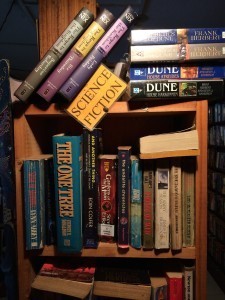 The Books of the Raksura is fantasy, following the adventures of one of the Raksura, Moon, as he finds a new home and family, only to have to defend them. Moon is a character who shines; you desperately want him to be happy, and his path towards that is deeply engaging. And the most recent book, The Harbors of the Sun, is out now!
The Books of the Raksura is fantasy, following the adventures of one of the Raksura, Moon, as he finds a new home and family, only to have to defend them. Moon is a character who shines; you desperately want him to be happy, and his path towards that is deeply engaging. And the most recent book, The Harbors of the Sun, is out now!
Max Gladstone’s The Craft Sequence. I had read the first three of these, but another nicely-priced ebook bundle let me pick them up all together and read them that way, which I highly recommend. They connect in a interesting and convoluted way that makes the series do what a series should – create a whole that is greater than the sum of the individual books. Awesome fantasy with a modern flavor and a delightfully careful attention paid to economics.
Kristine Smith’s The Jani Kilian Chronicles is military-flavored space opera with a strong and engaging protagonist, games with linguistics, and plenty of action. A protagonist who is flawed, fearless, and feisty, and a romantic life that adds to the book but is certainly not the focus. Not quite military SF but close, I guess – I’m never sure where space opera ends and military SF begins.
Short stories are not something I would normally take on a vacation – they’re candy, not sustaining rations. But there’s a lovely series collecting all of Theodore Sturgeon’s work that I’ve been picking up book by book, using them as rewards. I’m up to Volume Five of those, The Perfect Host. And yay! All of them seem to be available on the Kindle. If you’re an F&SF short story writer, Sturgeon is one of the people you should read, in my opinion, to see how brilliantly and beautifully he does things.
June 30, 2017
Writing and Gender Class
 Often when I add new classes, it’s because someone has specifically asked for them. I know whenever I teach something new, it’ll be a learning experience for me as well, because I’ll have to think hard, come up with an outline, figure out some writing exercises, and have some resources to provide people afterwards.
Often when I add new classes, it’s because someone has specifically asked for them. I know whenever I teach something new, it’ll be a learning experience for me as well, because I’ll have to think hard, come up with an outline, figure out some writing exercises, and have some resources to provide people afterwards.
That need for thoughtful preparation is why I’ve put off something frequently asked for, a class about Writing and Gender. But now I’ve been working on one, and the live version will take place on Saturday, August 26, 9:30-11:30 AM Pacific time. I am very pleased to say that Cheryl Morgan will be guest-speaking in it – I find classes with two teaching perspectives are usually much more interesting, and this class is going to be interesting, thoughtful, and stuffed full of good and useful information and concepts.
There’s plenty of time, but with stuff like this, I find I do well to start jotting down notes early and building on them over time, with one last frenzied spurt of effort dedicated to completion in the last week or so. Here’s some thoughts so far:
I want to discuss how modern Western views of gender have fractured, and concepts like asexual, aromantic, cis, gender fluidity, etc as well as moving outside binary thinking.
I asked on Twitter about fiction thqt does interesting stuff with gender and am compiling a list, but here’s a Storify with all those titles in it. Some science fiction that has dealt with gender: Ann Leckie’s Radchai series, Ursula K. LeGuin’s The Left Hand of Darkness, Deb Taber’s Necessary Ill — and what’s the name of that John Varley story where the woman switches genders and her husband has such a hard time with it?
For me, Susan Griffin’s Woman and Nature: The Roaring Inside Her was an important text in thinking about the construction of femininity and language, so I want to look at a couple of passages from that and see if I can derive an interesting writing exercise from that. It came out in the 70s, though, so I have some fears that it’s going to be dated.
Along the same lines, at least one writing exercise that invoves genderflipping (or other-flipping in a different way) a passage of writing. I’m looking for other ideas like that which help me show students different perspectives in a way that sinks in. So much writing depends on finding the unexpected angle, the voice that has been too quiet to hear before, the elusive scent on the breeze that tugs at some memory — that’s what is both thrilling and terrifying about exploring things in one’s writing.
I will remind you that classes afre basically half price if you register by July 1, and that there are three Plunkett slots – scholarships for people who couldn’t otherwise afford the class – in each one. I am always pleased when people take advantage of the Plunketts – so help make me happy by passing the word along to someone who might be interested!
June 26, 2017
Nattering Social Justice Cook: Celebrating Rainbow Hair
One place recent culture wars have been being played out has been the virtual space occupied by Twitter and its adjacent social media. Examining a particular hashtag or recurring phrase often provides insight into what the topic of the moment is, as well as what tropes and memes are being deployed.
A common adjective in many of the more conservative, alt-right, and other theater-of-outrage rants I’ve seen in the past couple of years is “rainbow-haired,” never in a positive sense. It’s usually paired with some form of “social justice warrior,” and often accompanied by an emotional catch-phrase or verbiage like “feels” or “drinking the tears.” There’s a lot of interesting stuff built into that particular fixation. So let’s dig around to find what’s contained in the phrase and its use in this pejorative sense.
The rainbow itself has plenty going on, symbology-wise. In many mythologies, it’s the bridge between heaven and earth, used by gods, heroes, and shamans. In the Christian allegory of Noah, it’s the sign of God’s covenant with humanity. Leprechauns hide their gold at the rainbow’s foot, Indra uses it for his bow, and in the Australian Dreaming, it adorns the scales of the Rainbow Serpent who created the world. It’s also got a maxim built into it: something positive that cannot appear without something negative happening first. There are no rainbows without rain, at least a little of which must fall into every life.
In 1978, this metaphor for something containing a multitude of variations became associated with gay pride and diversity, through the efforts of artist/drag queen Gilbert Baker, who said of it: “We needed something beautiful, something from us. The rainbow is so perfect because it really fits our diversity in terms of race, gender, ages, all of those things. Plus, it’s a natural flag—it’s from the sky! And even though the rainbow has been used in other ways in vexilography, this use has now far eclipsed any other use that it had.”
And we should not forget Skittles and the slogan “verb the rainbow.”
What happens when it becomes hair color that makes it particularly hate-worthy for dour conservatives? It’s something I’m fairly familiar with, since I started dying my hair with streaks of pink in 2006 when I found Loreal’s Color Rays on a Bartell’s shelf. The dye requires no pre-bleaching; it is alarmingly, wonderfully bright when it first goes on, and fades over the course of the next couple of months. While it only comes in three colors rather the multitudes other lines hold. I have yet to find another dye that lasts as long and well. I’ve tried plenty over the years, including Manic Panic, Ion, Arctic Fox, and Vibes. I wrote at length about the (over a decade-long now) experience in The Pink Hair Manifesto so I’ll avoid saying anything other than it’s something I anticipate continuing to do, particularly since it’s become part of my authorial brand.
Let’s ground the recent phenomenon of chemically-colored hair plumage historically, since it happened a few decades earlier than my decision. Fabulous colors required science to make it possible, but the earliest adopters were the punks, particularly Cyndi Lauper. This was considered pretty shocking; I can remember a girl at my high school dying a small patch of hers blue and having her father threaten to kick her out of the house as a result.
Rainbow hair, rooted in a counter-culture movement, revels in individuality and a certain DIY spirit (there is no shame in going to the salon for it, but I find it much more fun to do my own). It celebrates one’s appearance, draws the eye rather than shrinking away from it. It is something beautiful that those who don’t fit inside normal standards of beauty can have. It is playful, joyful, delightful at times.
Very recently it has spread like wildfire, and many of the people adopting it are millennials. This gives the anti-rainbow hair sentiment a double-whammy, providing an “oh these kids nowadays” moment while slamming anyone older for acting overly young. (Which implies that’s a bad thing, which isn’t a notion I agree with).
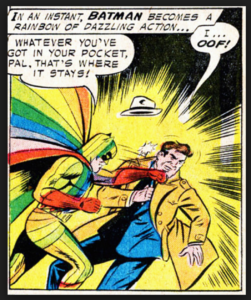 Here’s something that I think also often makes conservative minds bristle: it confuses gender norms. In traditional thinking, men aren’t supposed to care about or celebrate their appearance in the way women are. But rainbow hair appears all over the gender spectrum. Pull in the strand of meaning associated with gay pride, and the objectionability quotient increases.
Here’s something that I think also often makes conservative minds bristle: it confuses gender norms. In traditional thinking, men aren’t supposed to care about or celebrate their appearance in the way women are. But rainbow hair appears all over the gender spectrum. Pull in the strand of meaning associated with gay pride, and the objectionability quotient increases.
There’s a reason alt-right and other manifestations of conservative trollish rhetoric so often focuses on appearance, on fat-shaming or fuckability or even how a new Ken-doll wears their hair. It’s a reversion to the schoolyard insult, the way insecure children will be cruel to others in order to try to build their internal self-worth, a behavior many, but sadly not all, outgrow. Worthy of an essay in itself is the fact that it’s also behavior advantageous to advertisers: anxious consumers who want to fit in are willing to spend money in the effort.
This strategy of playground taunts based on a) something most people have little control over and b) a rigid set of norms is curious when we go back to the associated ideas of emotion and “feels” (I do want to talk about what additional stuff is built into the latter, but let me return to that in a second.) Emotion is traditionally seen as the domain of women and children; men keep a stiff upper lip and a silent heart of winter. Often emotionality is built into the verbs used to describe speech: shrill, shriek, and scream are favorites.
Big boys don’t cry. Women and other non-males do, and there is a Smeagol or Renfield-level insistence on the deliciousness of such tears, as with so much of the writing, which depends on mockery of other people’s passions or even what’s portrayed as their rude insistence on co-existing in this world.
It would be nice if pointing out the gender and other biases BS built into such language defused it entirely, but certainly it’s easier to keep it from affecting you if you’re aware of it. Life for many non-mainstream groups is a constant course of avoiding the particular lumps of low-level radiation scattered throughout our daily landscape. I’m aware I’ve got some shielding from that denied others.
So what’s built into “feels” beyond that? It’s a denigration of the memespeak and emoticons of the millennials, as far as I can tell, a curious mockery of Tumblr and lolcat culture. And there’s a reason that they fear that group, which is better (IMO) at seeing through the clouds of Internet argument than some of the other generations.
Literally four decades ago, when I was a kid, we saw football player Rosey Grier singing that it was all right to feel things:
I’m bemused that the people in the world I inhabit remain so wedded to a norm that seems harmful to men and makes them less capable of understanding the world. Maybe the feelz aren’t such a bad thing after all.
Which leads me to my conclusion, which is that it seems like an ineffective and overly dour point to hammer on. Overall, I can’t read any of the negatives being packed into rainbow-haired as actual negatives. Celebrate the rainbow connection, I say, and close accordingly with that.
Who said that wishes would be heard and answered when wished on the morning star?
Someone thought of that and someone believed it.
Look what it’s done so far.
What’s so amazing that keeps us stargazing and what do we think we might see?
Someday we’ll find it, the rainbow connection.
The lovers, the dreamers and me.
June 22, 2017
Guidelines for Guest Blog Posts
 Because I’ve run a number of guest posts on my blog and get offered additional ones from time to time, here’s the guidelines. I prefer they fall into one of the following areas but I’m open to interesting pitches:
Because I’ve run a number of guest posts on my blog and get offered additional ones from time to time, here’s the guidelines. I prefer they fall into one of the following areas but I’m open to interesting pitches:
Interesting and not much explored areas of writing
Writers or other individuals you have been inspired by
Your favorite kitchen and a recipe to cook in it
A recipe or description of a meal from your upcoming book
Women in the history of speculative fiction, ranging from very early figures such as Margaret Cavendish and Many Wollstonecraft up to the present day.
Please do send a pitch along with relevant dates (if, for example, you want to time things with a book release) to cat AT kittywumpus.net. If it sounds good, I’ll let you know. Length is 500 words on up. Please include 1-5 images that can be used with the piece and a 100 word bio that includes a pointer to your website and social media presences
June 10, 2017
You Should Read This: Some Recent Reading
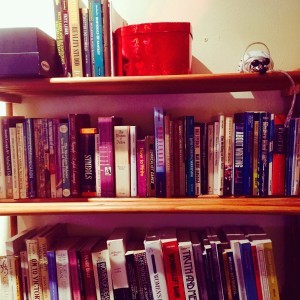 Post-Nebulas, I’ve been going through and trying to clear away a lot from my shelves and TBR list, particularly given that I still had a substantial armload from the International Conference of the Fantastic in the Arts and its munificent book tables. Here’s some particular recent favorites.
Post-Nebulas, I’ve been going through and trying to clear away a lot from my shelves and TBR list, particularly given that I still had a substantial armload from the International Conference of the Fantastic in the Arts and its munificent book tables. Here’s some particular recent favorites.
The Refrigerator Monologues by Catherynne Valente. Funny, fierce, and feminist. Valente gives a voice to some women who’ve got shrewd insight into and experience with the gender norms of the comic book world, including Phoenix, Harlequin, and Gwen Stacy. If you are a woman who loves comic books you should stop reading this and go find it. Fucking fantastic.
Deadwood by Pete Dexter. This historical novel is the one the HBO series was based on, and it’s terrific, particularly if you enjoyed that series and want to revisit some of those characters. The plain style of the writing combined with a sharp eye for historical detail is lovely, and it’s a book worth savoring. There are few things on earth more disappointing than reading a regular Western when you’re hoping for a weird one, so let me emphasize again that this is straightforward, non-fantastic fiction.
All Systems Red by Martha Wells. Far future SF with one of the most engaging first person narratives I’ve ever have the pleasure of watching in action, Wells’ independent, wry and stubborn Murderbot. Snappy and funny and yet thoroughly engaging. Alas, all too short since it’s a Kindle Single, but luckily it’s billed as the first in a series.
The Greatcoats by Sebastian de Castell. Early on in the first book, I knew I’d be picking up the rest, and did so, quickly working my way through to the highly satisfying conclusion. Basically French musketeers and a cool magic system, with the snappy dialogue and fast-paced, high-stakes action you would expect. Very enjoyable. I should note I picked them up due a Kindle deal that’s no longer going; if your budget is limited you will find more bang for your buck elsewhere (IMO).
Super Extra Grande by Yoss. In some ways this read like a more modern version of Keith Laumer’s Retief series, with a lot of the things about them that I loved as a teen and less of the stuff I’m not so fond of as an adult. Fast-paced and funny, and Spanglish scattered throughout made it more fun for me, but the mileage for a non-Spanish speaker may vary, I’m not sure. I picked this up because I wanted to read some Cuban science fiction; Yoss is one of the people at the forefront of that.
Dreadnought: Nemesis by April Daniels. Superhero YA with a trans main character who is identifiable and fabulous. I’m looking forward to the next in the series. Along the same lines, I want to point to Not Your Sidekick by C.B. Lee, also snappy and fun. I’m so happy to see superhero fiction have become an established thing in fiction; I will happily read as much of it as our fine genre writers can produce.
May 23, 2017
My Report: Pittsburgh 2017 Nebula Conference

Swag bags assembled and awaiting distribution.
I got back late last night, after a trip back that included a lost reservation, my luggage being overweight (how could that be? oh, look at all those books) so I had to repack a bit at the counter under the check-in agent’s impatient gaze, and the poor kid beside me throwing up steadily all the way from PIT to IAD. It’s always weird, the day after travel, because one feels as though you’ve been simultaneously on vacation and yet working harder than most days.I cannot begin to enumerate all the ways that weekend was wonderful. It was a great joy to see months and months of planning finally bear fruit and now we can relax for at least a couple days before thinking about next year. The programming was, in my opinion, outstanding. My only quarrel would be that there was so much good stuff that I could not get to every panel I wanted to, and that I could not spend enough time with the fabulous SFWA events team of Kate Baker, Terra LeMay, and Steven H Silver, who are responsible for everything that was wonderful.
One of the challenges for the Programming Team, led by Mary Robinette Kowal, was making sure the programming had something for all writers, whether they were tradpub, small press, indie, or hybrid. There were so many terrific, in-depth panels, including a wealth of shadow programming additions and office hours with writers and other publishing professionals. It made me think back to a Nebula from several years when I was on a lackadaisical panel about writers block that was, I think, so much less useful than it could have been and realize just how far the Nebula Conference has come from the days of “let’s all get together in a hotel and hand out the awards and then drink a lot.”
Literally the busiest person at the conference: SFWA’s fabulous Executive Director Kate Baker
Sarah Pinsker did a great job with the mentoring program, which matched up literally dozens of folks for mentoring sessions that were, for a number of folks, a major highlight of the con. I am sure many of the relationships formed there will last long after this weekend; I know I picked up two of my mentee’s books and am looking forward to reading them.The book depot structure, so adeptly administered by Sean Wallace, meant that everyone had a chance to have their books there. That had been an issue for a number of the indies last year and it was gratifying to see that problem addressed. I apologize for being one of the people who brought a stack of books in at the last minute; Sean was very patient with the number of us who did so.
I will not claim everything was perfect; I think I’m one of the people most acquainted with every behind-the-scene misstep and/or perceived slight that needed smoothing over. But so many of the small touches were stellar. The centerpieces on the banquet tables were charming robots assembled from vintage materials by artist Don L. Jones. There were plenty of chances for networking with partners and finding new and interesting opportunities. The gender-neutral bathroom was there, and usable, and in a place where people could find it. The Volunteer Breakfast on Sunday was lovely; we had a great turn-out and people liked the appreciation certificates and special SFWA temporary tattoos. (I still have a lot of these and am happy to mail them to SFWAns.) Toastmaster Kjell Lindgren was charming and smart and loves SF as much as any of us; he even showed us the books that drew him on his lifepath.
Speaking of reading, the swag bags were STUFFED with great stuff; I was making a number of happy noises while unpacking mine. I also enjoyed pointing people at the excess tables towards books that I knew were terrific, like Sarah Kuhn’s The Heroine Complex or Alaya Dawn Johnson’s Spirit Binders books.

I brought a robot home with me.
I got to wear several of my more high-end thrift store finds from this year, and also learned how to pack garments that consist mainly of chainmail-like layers of sequins. I also learned that such things really end up being heavy when you accumulate a few in one suitcase. My banquet dress was a big hit; I’ve never been asked before “who were you wearing?”, which amuses me and may underscore the lengths to which I will go in SFWA’s service.I did indeed announce that SFWA will be giving out a game-writing Nebula. Not an award with a separate name, like the Andre Norton or Ray Bradbury Award, but a Nebula. Why? Because game-writing deserves to be right up there in the ranks, not treated like a special case (no disrespect is intended there to either of the named awards). If you’re a gamewriter interested in providing feedback on how SFWA can help/serve gamewriters — or better yet, if you’re interested in helping make that happen by volunteering — I’d love to hear from you, and you can find my contact information here.
Next year’s Nebulas will again be in Pittsburgh and at the same hotel. Overall, they did a pretty solid job (with a few overwhelmed restaurant bobbles) and I know the manager and the events team sat down together on Sunday and went over everything that went wrong and how we can avoid them next year, down to details like marking the ramp’s edges with white tape so next time no one trips and has a bad fall over that invisible edge.
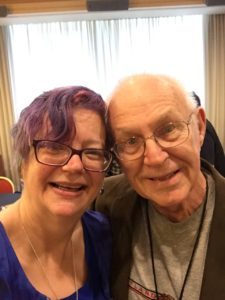
Selfie with SWA’s CFO, Bud Sparhawk.
The business meeting on Saturday went smoothly; I don’t think there were any real surprises for anyone. The officer election results were announced; thank you and welcome to incoming officers Curtis Chen, Andy Duncan, Jeffe Kennedy, and John P. Murphy, with special thanks again to Erin M. Hartshorn for agreeing to take up M.C.A. Hogarth’s sparkly war axe. The most contentious discussion was a member who felt that some members might prefer to write letters to the editor in the e-newsletter The Singularity in order to communicate with fellow members than use the discussion forums; the agreement was made that should anyone wish to write such a letter, we will include it in The Singularity. Afterwards we had a panel in the same room about all the stuff SFWA offers writers; the challenge was that we didn’t have enough time to cover it all.I don’t often get to surprise Steven H Silver, and yet Kate and I managed to keep the fact that Walter Day had made one of his awesome trading cards for him secret until the banquet. Walter’s trading cards are so nifty; he’s up to over 200 of them now and they were one of the nifty features of the swag bags. He also presented Jane Yolen with a special blown-up version of her new one. Jane gave a lovely speech, finishing with her Sally Field moment, and just generally was awesome and generous with her time all throughout the weekend.
The Super Nebula Showcase HumbleBundle has one day to go. So far it has raised more money for the SFWA Givers Fund, which administers grants to promote F&SF writing, than the Fund gave out last year. If you haven’t checked it out — there’s an awful lot of good reading in there.
Liz Argall did an adorable cartoon about the weekend, and another based on my closing words, which I hope she’ll post at some point, but I will reiterate them. It was so lovely to see you all. You are my people and I appreciate the trust you’ve given me. I’ll keep trying to steer things in a reasonable direction, but you’re the ones powering the ship. Thank you.
Many thanks to the Future Affairs Administration for live tweeting the Nebulas — they had over 4.5 million page views, which is awesome. I hope to be in Chengdu this winter to meet some of those viewers.
I am sure I have left out so much, and I suspect I’ll be updating this post throughout the next couple days as things occur to me, but I wanted to get a post up so peeps who weren’t there got to see some of the pictures. Here’s a few more.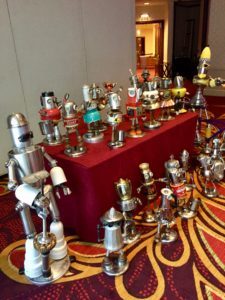
Robots awaiting distribution to the banquet tables.

With our fabulous Toastmaster.
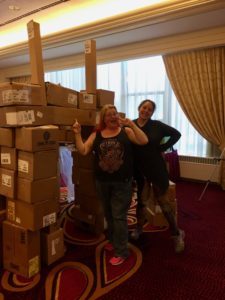
Walked into the SFWA office to find Seanan McGuire had built us a castle.


